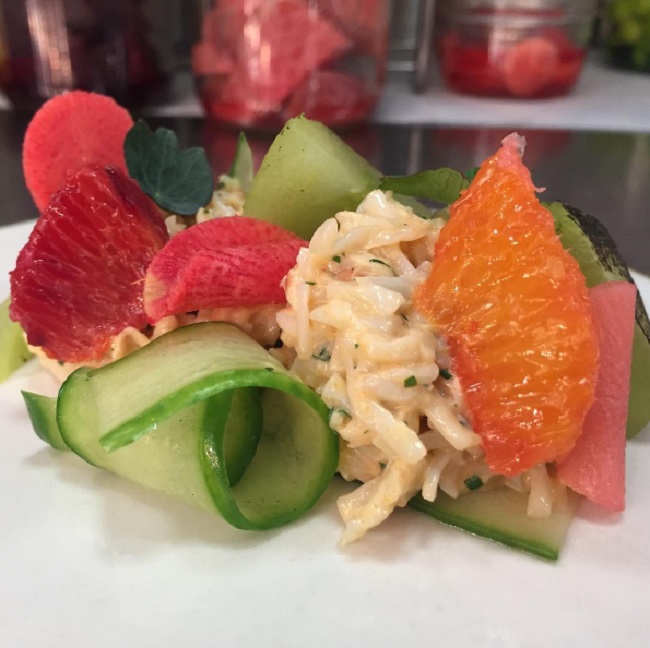Chef News, Competition, Competitions, Member offers, Miscellaneous, Recipes
Chefs Recipe: Smoked Beef Brisket & Pulled Pork from SEASON at Lainston House + Cookery School Competition and Offer

Chef News, Cookery Schools, Member offers, News, Recipes, Vegetarian
Chefs Recipe and Cookery School Offer: Watercress Soup by Raymond Blanc, Le Manoir aux Quat'Saisons
An A – Z of Unusual Menu Ingredients
Bewildered by the mythical sounding names of dish ingredients on menus these days? Well no longer do you need to be daunted by Dashi or nervous of Nigella (seeds). Here is our A-Z of what may be listed next time you dine and how to navigate your through the new seaweeds, fruits and grains.
A is for Agnolotti, a pasta typical of the Piedmont region of Italy. Little pockets of flattened dough they are typically filled with vegetables or cheese. Find a celeriac version on the menu at Petrus where they are served with pickle onion and black truffle – restaurant details here
B is for Burrata, a fresh Italian cheese made from mozzarella and cream. When the thin outer shell is sliced open a delicious rich buttery cream flows out. Find it on the vegetarian menu at Helene Darroze at The Connaught served with beetroot and dandelion – restaurant details here
C is for Ciflorette strawberries, an elongated low acidic, shiny fruit which are considered a superior variety. Delightfully sweet their fragile and delicate flesh means they are best eaten within a few days. Find them on the menu (and no doubt in the garden!) of Belmond Le Manoir Aux Quat’Saisons – restaurant details here
D is for Dashi, a class of soup and cooking stock used in Japanese cooking which provides a rich base for miso soup. Find it in the 10 Course Tasting menu at The Pass At South Lodge Hotel along with smoked eel – restaurant details here
E is for Edamame, young soy beans often served with chilli salt. Previously only found in Japanese restaurants and Asian supermarkets they are now something of a craze. Find them on the menu at Chisou, Knightsbridge – restaurant details here
F is for Fregola or Fregula, a type of pasta from Sardinia. Bead shape with a chewy texture and nutty flavour it comes in varying sizes and is made with semolina flour and toasted in the oven. Find it on the menu of Hurley House Hotel served with slow cooked pork belly – restaurant details here
G is for Gomashio or Gomaiso, a condiment used in Japan much as we would use salt. Made from unhulled sesame seeds and salt it is often sprinkled on plain rice. Find it in the Foie gras ‘domaine de Rouilly’ dish at The Greenhouse – restaurant details here
H is for harissa, a hot, aromatic chilli pepper paste used in many Moroccan dishes or served as a condiment. Spicy and fragrant it is tremendously versatile. Find it in yogurt served with the Momo Grill at Momo – restaurant details here
I is for Idiazabal, a pressed sheeps milk cheese from the basque and Navarre in Spain. Also served smoked it is full flavoured with a pronounced finish. Find it on the cheese menu at Iberica Farringdon – restaurant details here
J is for Jaggery, an unrefined cane sugar very popular in Southeast Asia. As well as being used as a sweetening agent it is used for making alcoholic beverages particularly rum.
K is for Kombu, known as King of Seaweed it is an edible kelp widely eaten in East Asia. Used to make umami rich dishes it can be found in many menus currently including the Skitake and Kale Omelette in the Tasting Menu at Alyn Williams at The Westbury – restaurant details here
L is for Longan, which literally translates in Cantonese as ‘dragons eye’ – so named as it resembles an eyeball when shelled. A member of the soapberry family to which Lychee also belongs, it is often used in Chinese sweet dessert soups.
M is for Meadowsweet, also known as Mead wort, a herb that grows in damp meadows and riverbanks. It is an aromatic plant that was held sacred by the Druids as it has an anti-inflammatory and antacid action. Find it served with beetroot, raspberry and buttermilk in the dessert at Fera at Claridges – restaurant details here
N is for Nigella Seeds, found in Tutankhamun’s tomb and mentioned in the Old Testament they are sometimes referred to as black cumin and have a bitter pungent onion taste. Find them in the Kalonji Baingan aubergine dish at Tamarind – restaurant details here
O is for Okra, also known as ‘ladies fingers’ this magical vegetable is originally from Africa. Another superfood it is now used in a wide range of cuisines and can be eaten raw, or its juice is used to thicken dishes. Find it served crispy at Quilon – restaurant details here
P is for Ponzu, a tangy citrus based sauce which is often added to soy, used in Japanese cuisine. Find it in the Pembrokeshire Crab dish in the Chef’s Tasting Menu at Pied a Terre – restaurant details here
Q is for quinoa, a tiny round seed, smaller than rice that is a complete source of protein and known superfood. Similar to couscous demand for the grain has risen sharply in recent years (oh and its pronounced KEEN-wah). Find it served as a side order with grilled avocado and asparagus at Le Caprice – restaurant details here
R is for Ramson Juice – Ramson is a woodland loving plant which is known as ‘Bears Garlic’ in Latin and considered a genuine super health food, often used in weight loss programs. Find it in the Cumbrian lamb dish at Adam Reid at The French – restaurant details here
S is for Sea Almond, a type of clam, often found as part of a fresh seafood platter. Also known as ‘dog cockles’ they may be seen on french menus as ‘amandes’ which can cause confusion. Find it in the shellfish course along with with ‘spiky artichoke’ at Sketch – restaurant details here
T is for Tropea Onion, also known as Torpedo on account of their elongated shape is an old variety of red onion for Calabria in Southern Italy. Grown on clay cliffs it has an extraordinary sweetness due to the soil and microclimates. Find it in the Taste of Spring menu at Marcus served with truffle and Winchester cheese – restaurant details here
U is for Uchucuta, a type of hot Peruvian salsa. Although not strictly an ingredient it is used to accompany many different meats and salads and with the growing number of excellent Peruvian restaurants you are bound to come across it. Find it at Lima Fitzrovia made with Avocado – restaurant details here
V is for Vacherin, a French/Swiss cow’s milk cheese traditionally made in the winter months when there is not enough milk to make Comte. With a rich voluptuous texture but mild taste it is currently available on the menu at Alain Ducasse at The Dorchester – restaurant details here
W is for Wakame sometimes known as sea mustard, a type of sea vegetable or edible seaweed. Sea-farmers have grown wakme in Japan since ancient times and it has a subtly sweet flavour. Find it in the the white miso soup at Aqua Kyoto – restaurant details here
X is for Xigua… ok we were a little stumped here. Xigua is a large melon with a hard green rind and juicy red flesh, delicious on a hot summer’s day – otherwise know as watermelon… cut us some slack?!
Y is for Yuzu or Citrus Junos, recently only found in specialist shops and restaurant menus but now available at Waitrose this bright fruit is likened to a lemon crossed with a mandarin orange. Find it in the Mackerel with horseradish dish in Menu X at Paris House in Woburn – restaurant details here
Z is for Za’atar, a spice blend from the Middle East the main ingredient is thyme mixed with ground sesame seeds. Perfect as a dip with oil, it is also used as a salad garnish, kneaded into dough and can be used as a meat glaze. Purchase it from Ottolenghi – details here
Find out more about the Luxury Restaurant Club – the UK’s largest fine dining club, where you can subscribe to enjoy instant rewards, invitations and insights from over 500 of the finest restaurants in the UK. Find out more here.

